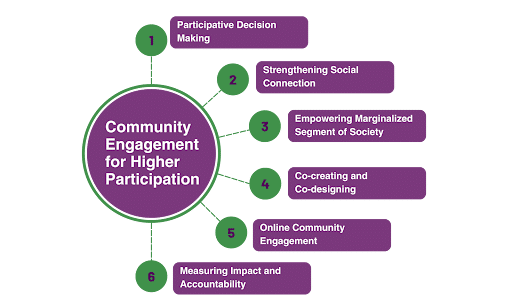Community engagement is a crucial element in today’s digital era. With the rise of online activity, brands have a significant opportunity to connect with their audience by actively participating in online communities. According to a recent research report by Amity, a substantial 82% of visitors prefer organizations that engage with online communities. In this blog, we will delve into the concept of community engagement and its pivotal role in fostering public collaboration.
Plumlogix is your one-stop solution for streamlining processes that collect insightful data for enhancing communication within a community!
What is Community Engagement?
Community engagement involves strategic communication and collaboration with community stakeholders to achieve common goals. This interaction is crucial for strengthening the connection between an organization and the community, whether it’s a government sector, nonprofit, or educational institution. The involvement of local people is essential for the success of projects and activities, and building strong relationships with them is vital for making a meaningful impact.
Examples of Community Engagement
Depending on the environment, countless activities can be included under the umbrella of community engagement. Some basic community engagement activities that the local government caters to in the city are as follows:
- Fundraising Event
These events are often held around a cause, the resources are collected from the local people to support the community. Other than that, these events develop unity and consideration among the members of the community.
- Outreach Activities
Activities are planned to facilitate the people of the society who otherwise would not be able to access them. Such efforts will increase the feeling of inclusion and belonging to all strata of society.
- Clean-up Initiatives
Setting up small projects, to clean up places accessible to all communities, is likely to increase the responsibility of the public to maintain and sustain the environment.
Why is Community Engagement important?
There is no one reason to state why community engagement is important, therefore, special efforts should be taken to establish community engagement strategies.
As an organization fostering collaboration with stakeholders at all levels, effective community engagement is crucial for maintaining and retaining relationships with the public. No institution including government organizations, non-profit, or educational institutions, can overlook the importance of this connection.
Here are some benefits of making community engagement your priority:
- Building Strong Connections with Communities
An organization’s local community engagement efforts bring the people together. A strong bond between the people helps create understanding and ownership of responsibilities.
- Managing the Common Needs of People
Establishing close connections with the public increases their participation in activities held for common interests. Fostering open communication allows information to flow from bottom to up.
- Promoting Collaboration and Trust
Community engagement promotes unity in the community. The constant communication with the stakeholders increases the trust in their decisions. Owing to this, people see communication as a way to bridge gaps.
- Making Informed Decisions
The involvement of the organization and stakeholders allows more transfer of information to see the big picture. The better the information the institution has, the better decisions can be made.
- Addressing Conflicts Before They Escalate
By collaborating with the locals, organizations can anticipate the issues that may turn into conflict. This is where community engagement addresses issues proactively to mitigate the risk of a possible conflict.
- Empowering the Locals
Community engagement empowers the local residents by involving them in the decision-making process to solve the problems. A satisfied society will increase the level of collaboration and volunteerism to achieve the goals of improving the quality of life.
Improve your community engagement with our innovative solutions at Plumlogix.
Who Benefits from Community Engagement?
Imagine a city’s authority is planning to build a mall at the heart of the city. By communicating this idea beforehand, the city administration staff can address the pain points before the final strategy, and mayors can gain support for the project. The open feedback loop makes the residents feel valued. As a result, together all the stakeholders can address the potential risks and issues like traffic divergence, duration of the project, and resources.
Now let’s look into who benefits from community engagement in a city:
- Benefits for Citizen
The locals develop close ties with the area of their residence. Therefore, by being participative in the community, people feel they are being heard and valued by the organizations. This brings a sense of empowerment for the people to use their voices to influence the decisions that have links to their lives directly. Similarly, open communications within the organization allow for a constant flow of information, giving the people more transparency in the processes and decisions made in the city.
- Benefits for City Leaders
In a city or community, the ones vested with the power and trust of the people are the ones who promote community engagement within the city. The communication with the residents brings forth a flow of information that helps in creating new strategies or adjusting existing ones for informed decision-making. Also, this communication acts as a source of performance feedback. The feedback highlights the potential risks in the form of problems and issues that can be anticipated and proactively addressed. Additionally, the city leaders can create a sense of trust with the residents.
- Benefits for City Administration Staff
The administrative staff is at the front line of all the collaboration and communication to successfully deliver the projects. First, they have a better understanding of the needs and problems of the local people so they can easily address them with tailored solutions. These solutions are formulated keeping in view the limited resources available. Secondly, direct communication with the people helps them navigate through any resistance in the form of conflicts and complaints in a better way. Lastly, by working closely with the residents they can see the result of their work and direct happiness of the residents leading to their job satisfaction.
How to improve Community Engagement in your city?
Most cities have participative residents who support, volunteer, and collaborate with social groups and other institutions in the city. The participative culture of a community helps the stakeholders get involved to reach new heights together. Here are some essential points to improve community engagement in your city:
- Correctly Identifying the Problem
It is vital to correctly identify the root cause of the problems that the people are facing. By asking the right questions, authorities can reach the conclusion of the actual problem. Traditionally there were town hall meetings, but now there are numerous ways to connect with the community online to get the answers.
- Online surveys:
Share surveys on online platforms. The residents can easily fill out the survey on their phones and authorities can get real-time information.
- Websites:
An organization’s website can be a good place to engage the people. Group chats with mediators can collect information by asking the required questions.
- Involving Diverse People
When engaging with the locals, connect with different peoples, naming a few; people from different ethnicities, religions, genders, and professions. Having a diverse audience, you have access to their views and knowledge. The enriched insights will ensure that the organization makes decisions that are in the best interest of everyone.
- Focusing on Community Engagement Strategy
To improve the community engagement of the city, stress should be placed on developing a strategy. For formulating strategies, a team of professionals should be selected with experience in the field and knowledge of the matter. Collect the right data and utilize it to make strategies that lead to success.
What are some Community Engagement Models?
Effective communication is key to achieving higher success rates and overcoming obstacles in any project. Following are some community engagement models that can help you establish stronger relationships with your stakeholders:
Model No. 1: Community Engagement Aiming for Higher Participation

- Participative Decision Making
Citizens are allowed to participate in the decision-making of strategies that contribute to people’s participation.
- Strengthening Social Connection
The public actively participates in agendas and activities strengthening their relationship with the authorities and each other.
- Empowering Marginalized Segment of Society
Actively listening to the voices of marginalized people helps highlight the challenges they are facing. Specific actions can be taken to resolve them.
- Co-creating and Co-designing
Participatory stakeholders are involved in all levels of the planning. They share their input and values in creating and designing policies and agendas.
- Online Community Engagement
Online platforms are easily accessible to the majority of the population, providing an opportunity to engage with a larger audience. People of all age groups spend a considerable amount of their time on online platforms. These platforms are the best places to engage for instant feedback.
- Measuring Impact and Accountability
Close connection with the public allows greater measurement of the impact of implementations. Establishing a framework and quantitative measures will act as a guide for quality assurance and the success of service.
Model no.2: The Organized Steps Model of Community Engagement

A well-structured approach to the communication process gives a better insight into the problem and the steps required to address it: Here are the steps of this model:
Step 1: Reflect on the issues and start the process of creating a strategy
Step 2: Identify the internal and external stakeholders and take the initiative to engage them
Step 3: Explain and communicate problems to the local community
Step 4: Collect preliminary data and analyze it for accurate insights
Step 5: Prioritize addressing urgent community issues and activities
Step 6: Document details to share with the stakeholders
Step 7: Finalize the plan, and start execution of the strategy
Step 8: Evaluate the process and reflect on the success of the strategy
Conclusion
The importance of community engagement cannot be overlooked. With the rapid sharing of information, everyone is keeping an eye out for what’s new. Take this opportunity to transform your business workflows and amaze your stakeholders. Ensure smooth running of operations with multiple things going on at the same time.





